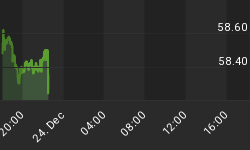Aggregate Opinion Drives Markets

Roughly half of the U.S. population owns stocks, which equates to approximately 156 million people. Those 156 million people along with millions more around the globe determine the value of our portfolios. When the aggregate outlook for the economy, earnings, monetary policy, and geopolitical developments is favorable, stocks tend to rise. Conversely, when the aggregate opinion of all investors shifts to a "we are concerned about the future" posture, stocks tend to drop as they did in 2001 and 2008. How likely is a 2001/2008 waterfall decline in stocks? To answer that question we will focus on investor conviction now vs. then.
Favorable Economic Trends
On December 30 we addressed the question of the likelihood of an imminent recession in the United States. The economic data on the first trading day of the year continues to align with the "not that likely" theory. From Bloomberg:
Applications for U.S. unemployment benefits declined last week to the lowest level in a month as the volatility typical during the year-end holidays waned. Jobless claims fell by 2,000 to 339,000 in the period ended Dec. 28, Labor Department data showed today in Washington. The median forecast of 26 economists surveyed by Bloomberg called for 344,000 claims.
What Does A Vulnerable Stock Market Look Like?
If you want to be prepared for the next inevitable bear market in stocks, it is logical to study past bear markets. Traders and institutional investors use moving averages to filter out day-to-day volatility, which allows them to focus on the underlying trend. Trends speak to investor conviction about the economy and markets. The 200-day moving average is used to monitor the health of the long-term trend. The 50-day moving average is used to monitor the intermediate-term trend. When the stock market's trend is tentative, it indicates a shift in the aggregate economic outlook of all investors around the globe.
2007: Warnings Were Present
In the S&P 500 chart below, confidence in future economic outcomes began to wane in late 2007. The 50-day moving average (in blue below) rolled over in a bearish manner three times before stocks dropped sharply in 2008. The 200-day moving average (in red) started to flatten out below the orange arrow, which was indicative of a vulnerable long-term trend in stocks.

Yellow Flags Before Dot-Com Bust
The exact same forms of observable and concerning evidence were present in 1999 and 2000, which provided ample warnings to investors before stocks plunged in 2001-2002.

How Does Conviction Look Today?
The answer to the question above is "much better". Compare and contrast the look of the 2013 chart below to the 2000 and 2007 charts above; the slopes of the 50-day and 200-day moving averages in 2013 are much steeper, which aligns with more sustainable trends. The chart below includes the 14 point drop that was taking place during Thursday's trading session.

The chart above tells us two things related to 2014:
-
The aggregate opinion, as measured on intermediate and longer-term time horizons, reflects much stronger conviction about future economic and market outcomes than what preceded the sharp drops in equity prices in 2001 and 2008.
-
Even if a bear market is in the 2014 cards, the topping process would most likely take several months allowing the slopes of the moving averages time to roll over in a bearish manner.
Manufacturing Aligns With Charts
Charts are used to monitor the aggregate interpretation of economic fundamentals. The 2013-2014 chart above aligns with recent improvement in the global economy. Thursday brought some additional backing for an optimistic economic stance. From Reuters:
U.S. manufacturing ended the year on a high note, growing in December at its fastest pace in 11 months, while the rate of job growth was the swiftest since March, an industry report showed on Thursday. Financial data firm Markit said its final U.S. Manufacturing Purchasing Managers Index rose to 55.0 last month, beating November's 54.7 reading and an initial December estimate of 54.4. A reading above 50 indicates expansion. A solid increase in output, for which the index rose to its highest mark in 21 months of 57.5 from 57.4 in November, boosted growth in the sector and increased demand for plants and machinery. "This tells us that business spending is picking up on the back of rising confidence, which adds to the sense that the recovery is (becoming) more self-sustaining," said Markit chief economist Chris Williamson.
Investment Implications

Is it possible Thursday's decline will morph into something more significant? Sure, it is possible. However, we should keep in mind the S&P 500 had 16 negative weeks in 2013 within the context of a bullish trend. Down days and down weeks fit into the countertrend category until proven otherwise. The rationale behind using the 50 and 200 day moving averages is described in more detail in this video. The concept of paying attention to incoming data, rather than trying to predict, was described on December 31. The unbiased data on the observable evidence front continues to favor stocks over bonds, or shorting. Consequently, we continue to maintain exposure to U.S. stocks (VTI), financials (XLF), energy (XLE), small caps (IJR), and global stocks (VT). How long will bullish conditions remain in place? You will have to ask the millions of investors around the globe, which underscores the rationale for observing and adjusting, rather than predicting and forecasting.















